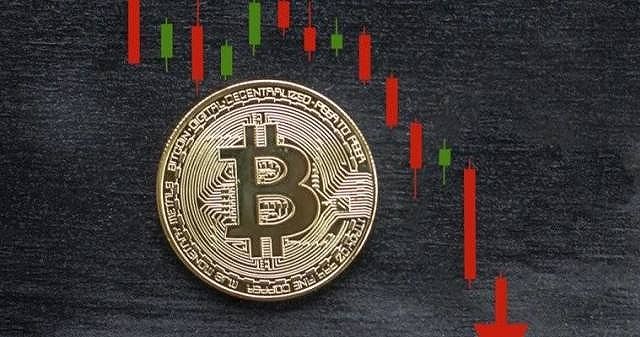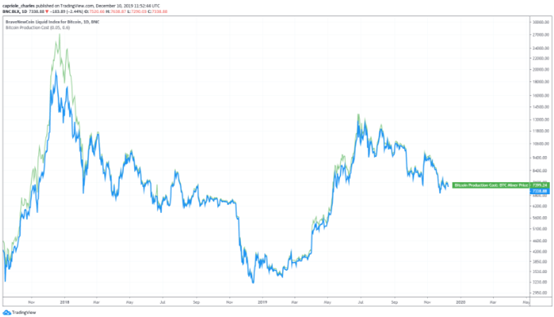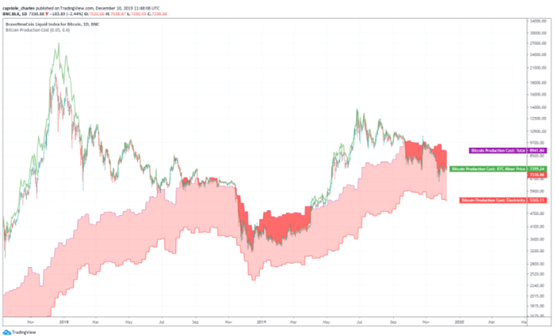Satoshi Nakamoto's theory of the crypto market after the bulls' collapse?
Author: Charles Edwards
Translation: First Class (First.VIP)
Editor's Note: The original title was "The pessimistic market after the bulls' defeat. Is Satoshi Nakamoto's theory still valid? 》
This article links Bitcoin's power consumption to the cost of Bitcoin production. In this way, we can gain insight into the historical profitability of bitcoin mining and learn when bitcoin miners are in trouble. In the past five years, the cost of Bitcoin's electricity has been the bottom of the Bitcoin market transaction price, which proves Satoshi's theory that the price tends to the cost of production.
- Perspectives | Five conjectures for the blockchain industry in 2020
- Blockchain can't save traffic NetEase circle and other products failure revelation
- Comment: Why did Satoshi Nakamoto give up being the richest man in the world?

Summary
Bitcoin's power consumption can be used to estimate the cost of Bitcoin production
Bitcoin production costs can be used to estimate the profitability of miners
Bitcoin mining has always been a very profitable business
2019 is the most embarrassing year for Bitcoin miners in the past five years
Bitcoin miners are currently suffering losses in the fourth quarter due to falling prices
Bitcoin electricity cost has always been the bottom of the Bitcoin market price
Lower pessimistic price threshold for mid-2020 is expected to be $ 8,000
· However, the impact of miners on supply and demand is declining, with Bitcoin's inflation rate at 3.8% and falling
This article links Bitcoin's power consumption to the cost of Bitcoin production. In this way, we can gain insight into the historical profitability of bitcoin mining and learn when bitcoin miners are in trouble. In the past five years, the cost of Bitcoin's electricity has been the bottom of the Bitcoin market transaction price, which proves Satoshi's theory that the price tends to the cost of production.
Commodity prices and production costs
Satoshi Nakamoto best summarized the relationship between the production cost of Bitcoin miners and the price of Bitcoin:
"The price of any commodity tends to tilt towards the cost of production. If the price is lower than the cost, then production slows down. If the price is higher than the cost, you can profit by generating and selling more products. At the same time, increased production It will increase the difficulty and push the cost of power generation to price.
In the coming years, when the new output currency accounts for only a small part of the existing currency, the market price will be more able to determine the cost of production than other methods. "
-Satoshi Nakamoto, 2010
Knowing this relationship, and based on a detailed survey of Bitcoin's power consumption, we can estimate the mining cost of Bitcoin.
Cambridge Bitcoin Power Consumption Index (CBECI)
In 2019, Cambridge University published a detailed research report that estimates the energy consumption of Bitcoin from November 2014 to the present.
This research is probably by far the most detailed bottom-up calculation of Bitcoin's global power consumption.

Cambridge Bitcoin Power Consumption Index (December 2019)
Cambridge University estimates bitcoin's electricity usage based on the assumption that miners will run miners as long as they can still make a profit on electricity. Other key assumptions behind these calculations include:
1. The global average electricity price for Bitcoin miners is $ 0.05 per kWh . Based on interviews with global miners and other consistent research including CoinShares
2. Energy efficiency of more than 60 mining machine models since 2014. Improvements according to manufacturer's specifications and recommendations from experts (considering actual use and overclocking)
3. The global average power use efficiency (PUE) of Bitcoin miners is 1.1 . PUE is the ratio of the total energy required to operate a mining facility (including cooling) to the energy required to operate a server. The University of Cambridge came to this data based on interviews with miners around the world. This is also in line with Google's data: average PUE 1.11.
Cambridge University's calculations assume that a package of lucrative mining equipment is equally weighted, which is probably the most thorough method of assessing global mining machine utilization, depreciation and energy consumption today.
All references to Bitcoin power consumption in this article are Cambridge University's "best guess" on Bitcoin power consumption.
Bitcoin production costs
The production cost of Bitcoin is an estimate of the global average dollar cost of producing one Bitcoin per day.
To date, every study on the cost of bitcoin mining has found that electricity is the main cost of operating equipment, and it is used here as a basis for estimating the cost of bitcoin production.
Based on Cambridge's power consumption, the production cost of Bitcoin can be estimated in the following ways:
1. Calculate the number of Bitcoins mined per day (based on Bitcoin's block reward and block frequency)
2. Calculate the electricity cost of Bitcoin = the daily electricity cost of mining a Bitcoin
3. Estimate the global average "total cost of electricity" = (Bitcoin electricity cost) / (Daily cost of running a Bitcoin mining equipment)
Then found that the production cost of Bitcoin is (daily electricity cost) / (total electricity cost ratio)
According to data from the University of Cambridge, there is another assumption to be calculated-the global average Bitcoin "total cost of electricity" (the third factor above). Electricity is the main factor affecting Bitcoin mining. Other Bitcoin mining costs are:
Hardware costs
· Bandwidth
· Salary
Rent
· Insurance
Cost of capital
We made different estimates of the "total cost of electricity", including:

Estimated Bitcoin's electricity cost as a percentage of total mining cost
In low-cost countries like China, wages, rents, insurance, and capital costs are low, and mining costs are almost negligible. Take China as an example. By 2019, China will account for about 60% of global Bitcoin mining.
Based on existing research, we found that several of the above estimates exclude general business costs (rents, wages, etc.) other than electricity operating expenses (OPEX) and hardware capital expenditures (CAPEX), so the total cost ratio is estimated to be 60 %.
According to Cambridge electricity data, this is equivalent to 5 years of Bitcoin production costs.

Bitcoin production cost
Bitcoin miner price
Comparing the price of bitcoin to its production cost is an interesting thing. Each token mined is sold at the market price, but ignores another income of the miner, which is the transaction fee.
In addition to Bitcoin rewards for each newly mined block, miners can also receive transaction fees for each block. The sender of the transaction gives the transaction fee according to the supply and demand relationship. Over time, the vast majority of the miner's income comes from the transaction fee, because the block reward will be halved.
Therefore, the production cost of Bitcoin should be compared with Bitcoin's revenue (that is, the market price of Bitcoin) and transaction fees.
We call this part the bitcoin miner price, which is equal to the bitcoin market price + (daily transaction fees) / (daily mined bitcoins).

Bitcoin miner's price changes with demand for on-chain transactions
Comparing the cost of bitcoin production and the price of miners, we can find that bitcoin miners have recently suffered a tight income and may also suffer short-term losses .

Bitcoin production costs and the price of Bitcoin miners
Bitcoin electricity cost, the lower price limit of Bitcoin
According to the cost of Bitcoin production, it is possible to gain insight into the profitability of Bitcoin miners. The price of bitcoin below the cost of bitcoin production is often a temporary situation, because high-cost miners fall first, the hash rate stagnates and falls, and miners are usually unwilling to sell at a loss.
However, Bitcoin's electricity costs provide a strong price support point.
In the short term, many miners are paying for "sunk" costs (such as purchased hardware), contract-locked funds (such as rent), or deferred payments (such as hardware upgrades). This means that Bitcoin miners can make losses in a short period of time.
This is because as long as the price of bitcoin miners is higher than the cost of bitcoin electricity, miners will lose money. If the cost of running the mining equipment is equal to or lower than the revenue, you may wish to continue to operate the equipment until the general business costs cannot support your operating expenses, but this state will not continue indefinitely, and the miners who have suffered losses have no income to re-run Investment (capital expenditure that keeps pace with the total hash rate), payment of rent contracts, wages and more.
According to data from Cambridge University in 2014, without further assumptions, it can be seen that the price of Bitcoin has never reached the cost of electricity for Bitcoin, although it was very close at one point in November 2018.
Historically, Bitcoin's electricity costs represent the bottom of the Bitcoin market price.
In recent years, the introduction of bitcoin futures has allowed bitcoin miners to lock in profits earlier, for example, when bitcoin prices are much higher than production costs, they will be short. However, these strategies lack effectiveness. The Bitcoin options introduced in 2019 may also help Bitcoin miners, provide them with stable cash flow, and effectively lock the minimum selling price of Bitcoin.
Miners struggle on the verge of profit
All this shows that Bitcoin miners are currently in a difficult situation. Most miners are losing money in the short term, with an average daily profit margin of 10% in 2019.
According to the University of Cambridge's electricity consumption data, even if 60% of the total electricity cost is significantly different from the assumptions, 2019 will be the lowest year for Bitcoin mining profits in the past 5 years.

Bitcoin miners are struggling on the brink of profit, and Bitcoin mining has always been a high-margin job
Bitcoin Prospects
The production cost of Bitcoin will double in the next Bitcoin halving (currently estimated in May 2020). When the block reward is halved, the daily production cost of Bitcoin is half the price of Bitcoin.

The production cost of Bitcoin doubled in half when it was halved in 2016. It is estimated that Antminer S9 will improve mining efficiency and reduce the room for rising production costs.
From the chart, if Bitcoin's hash rate and mining machine efficiency remain as they are today, then when the block is halved, the production cost of Bitcoin is $ 17,800.
Although the hash rate fluctuates greatly, historically, the price of bitcoin has been much more stable. The weekly average hash rate has never dropped more than 47% from its peak (2011). The second significant drop was in December 2018, a 37% drop.
The second biggest change affecting the cost of Bitcoin's electricity is the efficiency of mining machines. Historically, the efficiency of mining machines has been increasing every year.
Even if Bitcoin's hash rate drops by 40% (from today), and the efficiency of the mining machine will increase by 25% in the next six months, Bitcoin's electricity cost will also be close to $ 8,000. This shows that the pessimistic price of Bitcoin in June 2020 was $ 8,000. This is 8% higher than the current Bitcoin price of $ 7,350. (First-class warehouse note: Bitcoin price is based on the author's post on December 13, 2019)
This model also has limitations, that is, the proportion of bitcoin supply held by miners in the total supply chain has decreased. Bitcoin's current inflation rate is 3.8%, and it has fallen exponentially. After 2020, the impact of each new bitcoin will be significantly reduced by half . Therefore, as mentioned above by Satoshi Nakamoto, the cost of bitcoin electricity as the lower price limit will gradually fade over time.
Thanks for reading, please reprint the copyright information!
We will continue to update Blocking; if you have any questions or suggestions, please contact us!
Was this article helpful?
93 out of 132 found this helpful
Related articles
- Looking for "new rich mines" in the automotive industry: blockchain may become a breakthrough
- Opinion: 5 predictions for DeFi in 2020
- Case study | How government governance applies blockchain technology
- Latest Global Central Bank Digital Currency Guide
- Perspective | Bitcoin Operating System: What kind of applications will emerge from liberating information and communications?
- Dry goods | Starting from three bottlenecks to solve blockchain scalability issues
- Summary of blockchain security incidents in 2019, global loss exceeds $ 6 billion






